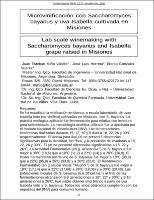Microvinificación con Saccharomyces bayanus y uva Isabella cultivada en Misiones = Lab scale winemaking with Saccharomyces bayanus and Isabella grape raised in Misiones

Date
2011-12-30Author
Miño Valdés, Juan Esteban
Herrera, José Luis
González Suárez, Erenio
Metadata
Show full item recordAbstract
Se ha estudiado la vinificación en blanco, a escala laboratorio, de uvas Isabella tinto (no vinífera) cultivadas en Misiones, con S. bayanus. La práctica enológica aplicada fue fermentación pura relativa con levadura pura seleccionada. La metodología analítica utilizada fue la aprobada por el Instituto Nacional de Vitivinicultura (INV). Las fermentaciones isotérmicas realizadas duraron 15, 12, 10 y 9 días a 18, 22, 26 y 30ºC respectivamente. El Anova para á=0,05 no presentó diferencias significativas para la densidad, los ºBrix, y la población de levaduras a 18, 22, 26 y 30ºC. El pH no presentó diferencias significativas a 18, 22 y 26ºC. La Actividad Fermentativa (en g. azúcar.día-1) de S. bayanus fué mejor a 30ºC (18,6) que a 18ºC (11,2) a 22ºC (14) y a 26ºC (16,8). El Poder Fermentativo (en % v/v) de S. bayanus fue mejor a 18ºC (98,9) que a 22ºC (95,9) a 26ºC (93,9) y a 30ºC (82,8). El Rendimiento Fermentativo (en g azúcar inicial. ºAlcohol-1) de S. bayanus fué mejor a 18ºC (17,14) que a 22ºC (17,68) a 26ºC (18,06) y a 30ºC (20,48). Las poblaciones iniciales de S. bayanus (6,6.103cel.mL-1) al final de las fermentaciones alcanzaron 8-9 generaciones a 18º, 22º y 30ºC y 9-10 generaciones a 26ºC. Fue viable obtener vino blanco a partir de uva Isabella tinto y S. bayanus. Todos los vinos obtenidos cumplieron con los requisitos del (INV) para consumo humano. Lab scale winemaking white from Red Isabella grape (not vinifera), raised in Misiones, whit Saccharomyces bayanus, they have been studied. The enological procedure involved the use of relative pure fermentation whit pure yeast selective. Analytical procedures approved by National Institute of Vitiviniculture (INV-Argentina) were applied. The isothermical fermentations carried out at 18, 22, 26 and 30ºC lasted 15, 12, 10 and 9 days, respectively. The Anova whit á = 0,05 did not have significant diferent for the density, ºBrix, pH and population of yeasts at 18, 22, 26 and 30ºC. The pH did not have significant diferent at 18, 22, and 26ºC. The fermentative activity (in g. sugar.day-1) of S. bayanus was better at 30ºC (18,6) than at 18ºC (11,2); at 22ºC (14); at 26ºC (16,8). The fermentative power (in % v/ v) of S. bayanus was better at 18ºC (98,9) than at 22ºC (95,9) at 26ºC (93,9) and at 30ºC (82,8). The fermentative profitability (in g.sugar.ºAlcohol-1) of S. bayanus was better at 18ºC (17,14) than at 22ºC (18,06); at 26ºC (16,8) and at 30ºC (20,48). The initial populations of S. bayanus (6,6.103 cel.mL-1) at the end of the fermentations they reached 8- 9 generations to 18º, 22º and 30ºC and 9-10 generations at 26ºC. White wine from Isabella tinto grape and S. bayanus at the same grape was viability and all wines obtained fulfilled of the National Institute of Vitiviniculture requirements for human consumption.
Collections
The following license files are associated with this item:


